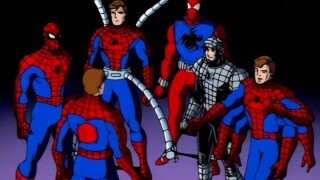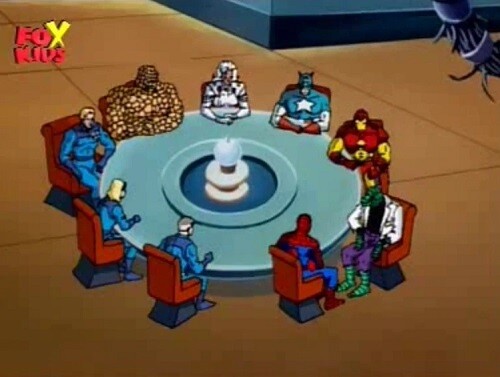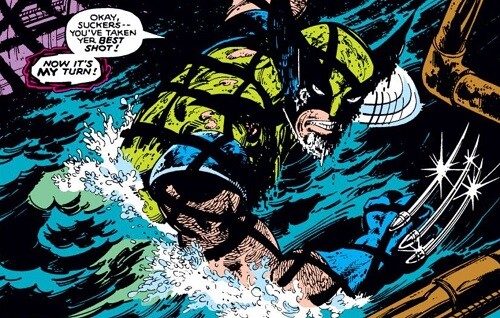How '90s Superhero Cartoons Prepared Us For The 'Cinematic Universe' Era

The 1990s were an intensely specific historical moment – the Cold War had just ended, everybody had landlines, and pre-internet peoples took to local forests to harvest their precious smut. This week, Cracked's taking a look back at those artifacts of Nineties culture and how they shaped our present. Check out part 1 and part 2.
Movies no longer spawn sequels -- they spawn whole dang universes. The Conjuring? That's a universe. Transformers? Universe now, bay-bee. King Kong and Godzilla? Scoot over because you're sharing one, sorry. Wes Anderson's movies? Yeah, probably; why not. Marvel Studios is usually blamed/thanked for this development, but we submit that the "shared cinematic universe" craze wouldn't be possible if our minds hadn't been prepared by what future historians will surely declare one of the high marks of popular entertainment: '90s superhero cartoons. No, seriously!
Don't Miss
Think about it, these shows pulled off stuff like ...
They Introduced Millions Of Kids To The Concept Of Long-Ass Storylines
For the majority of kids watching cartoons in 1992 (we're excluding the weird ones who were already into anime), every superhero show they'd previously seen followed the same formula: the heroes get into a pickle, the heroes get out of said pickle, and their lives reset back to the exact point they were before the episode started. There was rarely any progression because A) the creators didn't even know which order the episodes would be aired in, and B) these were literally just 20-minute commercials for actions figures, anyway. No one expects character development from a Barbie or a Pop-Tarts ad, so why should He-Man ones have it?
So let's say you're watching an episode of that new Batman show on Fox Kids where Bruce Wayne's buddy Harvey, who was there in the very first episode, gets into trouble with some gangsters. The whole time, you're thinking, "Oh boy, how's good ol' Harv gonna get out of this one?" After all, in a previous episode, Poison Ivy had nearly killed him via smooching, but he was okay by the end. And sure enough, even though clumsy Harvey stumbles face-first into a ball of fire and ends up in the hospital again, the doctors get to work on him, and by the time the credits roll, he's back to norm-- HOLY CRAP!

Warner Bros. Animation
Harvey starts going by "Two-Face" in the next episode. In a way, the end of that episode was even more shocking because there was no "TO BE CONTINUED" this time. Harvey wasn't cured by a magical serum or, like, the power of friendship -- he was stuck as a half-zombie-looking madman for good (or until he developed a third personality in one of the show's last episodes, anyway).
Batman: The Animated Series was still, for the most part, made out of self-contained episodes you could watch in any order. The same wasn't true for the X-Men cartoon that debuted on Fox Kids around the same time. The first episode introduced all of your favorite X-Men ... and some guy named Morph, who wasn't in the badass opening theme and whose most impressive power was "making Wolverine laugh." Oh, and he insisted that the X-Men's first big mission was gonna be a cakewalk, which is like the superhero equivalent of saying he's "two weeks away from retirement." Morph kinda sticks out like a sore thumb if you're already familiar with the X-Men, but most kids in 1992 weren't, so they never saw it coming when he was murdered by giant killbots 20 minutes into the show.
And that was just the start of a storyline that took over the whole first season. The second season had a running plot, too, plus a sub-plot about Professor X and Magneto pulling an Enemy Mine while stuck together in a prehistoric jungle. Meanwhile, Morph came back as a bad guy, was gradually rehabilitated, and rejoined the X-Men in the final episode. His years-long saga book-ended the whole show, sort of like Two-Face's did in Batman: The Animated Series. (Harvey would appreciate the parallelism.)
For the first time ever, these shows were bringing actual comic book-style continuity to cartoons. The stories actually mattered and had a direct effect on future episodes, and the changes in the show were more than just ways to introduce new action figures. In 1994, the Spider-Man animated series went all-in on this idea and straight-up made no sense if you didn't pay attention to the "Previously on ..." segments, especially during the 14-part storyline where Spider-Man mutates into Man-Spider, and the show mutates from "children's entertainment" to "body horror."
Incidentally, that story featured some other mutated freaks as guest stars: the X-Men, exactly as they appeared in their own cartoon, pioneering another aspect of today's comic book movies that we take for granted ...
They Were Our First Exposure To Real Shared Universes ... AND Multiverses
Spider-Man wasn't able to return the favor and appear on X-Men due to licensing issues, but the creators still managed to sneak his hand into the "Dark Phoenix" saga, and you know what? Even that tiny little "THWIP" was exciting as hell back then. Similarly, hundreds of thousands of young nerd minds were blown when a 1995 episode of the Fantastic Four cartoon showed the Juggernaut's arm coming out of the sea, which is exactly where the X-Men had left him a year earlier (he's very good at holding his breath).
But that episode went even further: not only did it show Wolverine and pals in their civilian clothes and Spidey himself in an alternate costume (again, due to dumb lawyer BS), but it also featured the Thing fighting the Hulk -- like, all of the Hulk, not just his arm or leg or some other appendage. Better yet, this led to a rematch a year later in Hulk's own animated show. Iron Man and War Machine also tussled with Hulk both in their show and his, then came to stay with Spider-Man for a few episodes when they got canceled. At some point, Tony Stark and other random Avengers assisted the Fantastic Four against Ego, the Living Planet, and then Ghost Rider and Thor (both of whom had previously cameoed in X-Men) helped out the FF fight their greatest enemy: low ratings. But also Galactus!
Thor and Ghost Rider later stopped by Hulk's show to get their customary beatings. Our point being: these different shows were clearly meant to be set in the same universe, and in the '90s, that was kind of mind-blowing. It still is, especially considering that they managed to pull this off while being handled by different production companies. This resulted in tons of dumb continuity errors and inconsistencies, but if you think about it, that just makes these shows more like the comics.
Spider-Man made up for his lack of (full body) cameos in other shows by hosting the most ambitious crossover of the Marvel Animated Universe. 21 years before Infinity War, the final season of Spider-Man had a storyline in which Spidey needs some assistance for a cosmic battle between good and evil and recruits Iron Man, Captain America, the Fantastic Four, and ... precisely one X-Person, Storm, because hers was the only voice actor who didn't have to be flown in from Canada, and these episodes were already getting pretty expensive.

Marvel Animation
Those episodes were followed by an even more fascinating crossover between Spider-Man and, well, himself. Several himselves. Yes, the '90s had its own version of Into the Spider-Verse, starring Six Arms Spider-Man, Rich Dick Spider-Iron-Man, and a real-world actor playing Spider-Man who's like, "Why am I here?" The answer, naturally, was "to introduce Spidey to Stan Lee in the series finale."
Meanwhile, DC took more of a "quality over quantity" approach to their world-building (let's face it, that Fantastic Four show WAS kind of a turd). The DC Animated Universe expanded slooooowly, from Batman: The Animated Series introducing Zatanna to Superman: The Animated Series guest-starring Green Lantern and Flash, to Justice League Unlimited showing us, like, every DC hero ever. Along the way, they also toyed with the idea of alternate timelines: Lois Lane once tripped and fell into a parallel reality in which Superman goes evil, an idea expanded in a Justice League two-part story set in a darker world where all the heroes are violent jerks.
It feels like the concept of different franchises sharing the same multi-timeline continuity is only entering the mainstream now, but it was there all along, in cartoons that were enjoyed by a whole generation of kids. Maybe one thing is connected to the other -- these shows prepared our young brains to accept today's complex mega-franchises. Of course, we're guessing none of it would have taken off if it wasn't for the final and most important ingredient in the formula ...
These Were The First Shows That Didn't Openly Despise The Source Material
Before the '90s, superhero shows on TV largely fell into two categories: those that went "Hey, it's just comics!" and those that went "Ugh, it's just comics ..." The Adam West Batman show was a joyful piss-take on the Dynamic Duo, while the Lou Ferrigno Incredible Hulk one went out of its way to distance itself from the comics, down to changing the character's real name -- either because the showrunner thought it sounded "too comic book-y" or "too gayish," depending on who you believe.
Animated shows, on the other hand, were specifically made for children or, best case scenario, stoners. Either way, they assumed the audience were total morons.
That's from the 1978 Fantastic Four show where the Human Torch was replaced by an annoying robot sidekick amid (though not exclusively because of) concerns that viewers would set themselves on fire. The next year, the Thing got his own spin-off show in which he was changed into a teenager named Benjy Grimm, who used magic rings to turn into a mass of orange rocks. Bear in mind that this crap aired while, in the comics, Iron Man dealt with his alcoholism, and Flash grieved the death of his wife.
DC shows weren't doing much better. While the comics side achieved new artistic heights via Watchmen and Dark Knight Returns, the Super Friends faced a version of Darkseid who was mostly just horny for Wonder Woman. The '90s shows set themselves apart merely by acknowledging that superhero stories don't have to be dumb. They not only adapted dozens and dozens and dozens of classic tales from the comics, but they did it well. Season 3 of X-Men is still the best adaptation of the "Dark Phoenix" saga, with many scenes pulled right out of the comics pages:

Marvel Comics
The Spider-Man show gave fans a way to get up to speed on where Venom and Carnage came from without having to look up years of issues scattered across like 12 comics series. And, while the DC Animated Universe shied away from direct adaptations after Batman: The Animated Series, it ended up giving us the most respectful (and heartbreaking) cinematic take on an Alan Moore comic to date:

DC Comics
The DCUA was so good, the comics themselves started taking notes, and the influence eventually spread to the movies -- from Mr. Freeze's tragic origin in Batman & Robin to Harvey Dent's explosive mishap in The Dark Knight to Harley Quinn's... everything, since she was created for BTAS. Something similar happened at Marvel: the influential Age of Apocalypse crossover (and, by extension, its pseudo-sequel House of M) was actually inspired by an episode of the '90s X-Men show, and not the other way around as fans originally thought due to the whole "it takes like a year to make a cartoon episode" thing.
Also, it's important to remember that, for 20th Century Fox, the first X-Men movie wasn't really a comic book adaptation; it was an extension of that weird cartoon that had made them so much money a few years earlier. Ironically, while the golden age of superhero films it helped inspire got underway, the MCUA itself sort of fizzled away through a series of increasingly embarrassing shows. One of the last ones was Silver Surfer, which ended on an unsolved cliffhanger appropriately showing Thanos destroying all of reality.
We're gonna go ahead and assume that this was the actual end of the Marvel Animated Universe because that's more poetic than "and then they did an Avengers show that absolutely sucked ass and tanked the whole franchise."
Follow Maxwell Yezpitelok's heroic effort to read and comment on every '90s Superman comic at Superman86to99.tumblr.com.
Top Image: Marvel Television
For more Cracked deep dives, be sure to check out:
MCU WEEK:
The 'Avengers' Comic That Basically Created The Modern Superhero Movie
Why Marvel Studios Is Branching Out Beyond Superheroes-- Sort Of
Marvel's Long And Confusing Path To Figuring Out Television
How Marvel Handles 'Black Panther' Is A Heartbreaking Task
All of the New Marvel Characters Getting Set Up In Phase 4
The Long, Stupid Road To A Watchable ‘Fantastic 4’ Movie
SUPERMAN WEEK:
4 Reasons Anyone Who Says 'Superman Is A Boring Superhero' Is Full Of It
4 Reasons O.G. Superman Is Even More Relevant Today
5 Superman Stories That Are Canon Kryptonite
4 Ways 'Death Of Superman' (Accidentally) Changed Pop Culture
4 Superman Movie Scenes That Were Dumb AF In Retrospect
JOKER WEEK:
The Early Obstacles On Joker's Path To Comic Icon
Why Do We Even Have Batman Movies Today? The Joker.
No One Was Ready For Mark Hamill's Joker ... Least Of All Mark Hamill
That Time DC Comics Turned The Joker Into David Bowie
A Dark Knight's Tale: How Heath Ledger Created A 21st Century Joker
The Weird Confusing Tale Of The Most 'Huh?' Movie Joker: Jared Leto
'Joker' Made A Billion Dollars, And That's Too Much Money To Ignore
